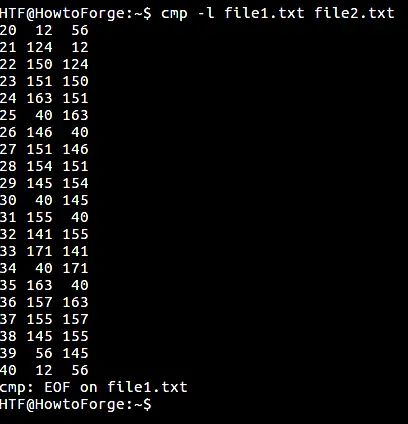https://www.howtoforge.com/linux-cmp-command
Pretty much regardless of your role, if your regular work involves doing stuff on the command line in Linux, you may find yourself in a situation where-in you'd want to compare two files using a command line utility. There are several command line tools that let you do this, and one among them is the 'cmp' command.
In this tutorial, we will discuss 'cmp' through easy to understand examples. But before we do that, it's worth mentioning that all examples and instructions mentioned in this tutorial have been tested on Ubuntu 16.04LTS.
For example:
Moving on, the tool also allows you to skip different number of bytes from both files. This can be done in the following way:
Pretty much regardless of your role, if your regular work involves doing stuff on the command line in Linux, you may find yourself in a situation where-in you'd want to compare two files using a command line utility. There are several command line tools that let you do this, and one among them is the 'cmp' command.
In this tutorial, we will discuss 'cmp' through easy to understand examples. But before we do that, it's worth mentioning that all examples and instructions mentioned in this tutorial have been tested on Ubuntu 16.04LTS.
cmp command
The 'cmp' command lets you carry out byte-by-byte comparison of two files. The utility provides several features in the form of command line options. In this tutorial, we will discuss some of the key options that'll give you (a beginner) a good idea about how the tool works.1. How to compare two files using cmp
In its simplest form, you can use 'cmp' in the following way:
cmp [file1-name] [file2-name]
As already mentioned, the tool compares two files byte by byte. As a
difference is found, the tool stops and produces an output that tells
which line and byte the difference is in.For example:
cmp file1.txt file2.txt
As you can see in the above screenshot, the output clearly says the files differ at byte 20 in line 1.
2. How to make cmp print differing bytes
If you want, you can also make 'cmp' display the differing bytes in its output. This can be done using the -b command line option.
cmp -b [file1] [file2]
For example:
cmp -b file1.txt file2.txt
In this case, as you can see in the screenshot above, the difference
is in the 17th byte, which is 'l' in file1.txt and 'i' in file2.txt. The
values 154 and 151 are the values for these bytes, respectively.3. How to make cmp skip some initial bytes from both files
If you want, you can also make 'cmp' skip a
particular number of initial bytes from both files, and then compare
them. This can be done by specifying the number of bytes as argument to
the -i command line option.
cmp -i [bytes-to-be-skipped] [file1] [file2]
For example:
cmp -i 10 file1.txt file2.txt
Note that in cases like these (where you use -i to skip bytes), the
byte at which the comparison begins is treated as byte number zero.Moving on, the tool also allows you to skip different number of bytes from both files. This can be done in the following way:
cmp -i [bytes-to-skip-from-first-file] : [bytes-to-skip-from-second-file] [file1] [file2]
For example:
cmp -i 4:7 file1.txt file2.txt
4. How to make cmp display byte position (and value) for all differing bytes
If you want, you can also make the 'cmp' command print byte position and byte value for all differing bytes. This feature can be accessed using the -l command line option.
cmp -l [file1] [file2]
For example:
cmp -l file1.txt file2.txt
The first column in the output (example
shown above) represents the position (byte number) of differing bytes.
The second column represents the byte value of the differing byte in the
first file, while the third column represents the byte value of the
differing byte in the second file.
5. How to limit number of bytes to be compared
The tool also allows you to limit the
number of bytes that you want to compare - like, you may want to compare
at most 25 or 50 bytes. This can be done by using the -n command line option.
$ cmp -n [number-of-bytes-to-be-compared] [file1] [file2]
For example:
$ cmp -n 25 file1.txt file2.txt
6. How to display progress meter while using cmp command
While comparing large files (or even partitions) using 'cmp', you may want to see the progress of the ongoing comparison. This can be done using the 'pv' command along with the 'cmp' command. Here's the command template that you can use:
$ pv [file1] | cmp -l [file2] > [output-file]
For example:
$ pv file1.txt | cmp -l file3.txt > output.txt
Note that the file 'output.txt' will
contain all the output that 'cmp' command produces. The progress meter
(that you can see in the above screenshot) is produced by the 'pv'
command.
The 'pv' command usually doesn't come
pre-installed in Linux (it doesn't on Ubuntu at-least). But you can
easily install it using the following command:
sudo apt-get install pv
7. How to make 'cmp' suppress output
The tool also allows you to suppress the output it produces normally. This can be done using the -s command line option.
$ cmp -s [file1] [file2]
For example:
$ cmp -s file1.txt file2.txt
This option may come in handy when using the 'cmp' utility in
scripts. For example, depending on whether the files are identical or
not (which one can tell by accessing the command's exit code), you might
want to display a custom message instead of the output the tool
normally produces.





No comments:
Post a Comment